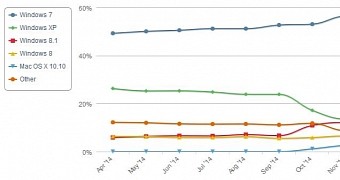Despite Microsoft's efforts to move users to modern platforms and to stir up interest in Windows 10, most people are still running Windows 7 on their computers, pretty much because of the desktop familiarity and its outstanding performance on older hardware configurations.
Windows 7 is currently the top desktop operating system in the world and that's very unlikely to change anytime soon. Living proof are these statistics provided by Net Applications, which perfectly show that Windows 7's market share skyrocketed in the last 12 months, despite the arrival of Windows 8.1 and the introduction of Windows 10 Technical Preview.
Back in April 2014, when Microsoft pulled the plug on Windows XP, Windows 7 was powering 49.27 percent of the PCs in the world, but it reached a new important milestone the next month, when it achieved a market share of 50.06 percent and officially powered 1 in 2 PCs in the world.
Windows 7 up, Windows 8.1 not so much
Since that moment, Windows 7's market share was going up every single month and peaked at 56.26 percent in December 2014. The same month, Windows 8.1 reached the lowest market share since October 2014, dropping to 9.49 percent.
Right now, Windows 7 has a market share of 55.99 percent, while Windows 8.1 is installed on 10.49 percent of the computers across the world.
The core Windows 8 is not at all doing very well, mostly because users are upgrading to 8.1, so it has a market share of only 3.55 percent right now.
So, who's going to stop Windows 7? It's pretty clear that Windows 8.1 can't even get close to Windows 7's market share and it really has serious problems in its fight against Windows XP. Right now, no less than 19.15 percent of the PCs out there are powered by XP.
Windows 10 is probably the first answer to today's question. Windows 10 is the next ambitious plan for the operating system market and it's often advertised as an improved version of Windows 7, with a modern Start menu and plenty of new features.
But there's still no doubt that Microsoft will have a hard time in January 2020, when Windows 7 support comes to an end and the company is very likely to get through a new “Windows XP” moment if no powerful alternative is released until then.

 14 DAY TRIAL //
14 DAY TRIAL //